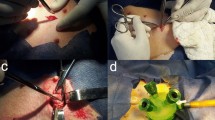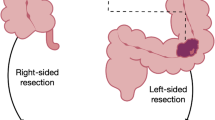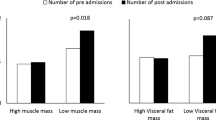Abstract
OBJECTIVE: To investigate the changes of visceral fat, as compared with total and subcutaneous adipose tissue (AT) in obese patients operated with laparascopic adjustable silicone gastric banding (LAP-BAND).
SUBJECTS: Six premenopausal morbid obese (body mass index range: 41.4–44.2 kg/m2) women, aged 38–42 y, operated with LAP-BAND, evaluated before, 8 weeks after, and 24 weeks after surgery.
MEASUREMENTS: Fat distribution was analysed by total body multi-slices MRI. Total AT, gluteo-femoral subcutaneous AT, abdominal subcutaneous AT, and abdominal visceral AT volumes were measured. FM was calculated from MRI-determined total AT volume and AT density.
RESULTS: A weight loss of 9.9±3.8 kg was observed in the first 8 weeks after LAP-BAND (0–8 weeks), and a further weight loss of 7.1±4.9 kg in the subsequent 16 weeks (8–24 weeks). Total AT showed a statistically significant reduction of 6.2±4.0 l in 0–8 weeks and a further significant reduction of 7.7±3.9 l in 8–24 weeks (P<0.01 from baseline). A similar trend was observed for both abdominal and gluteo-femoral subcutaneous AT. Visceral AT showed a statistically significant reduction of 1.0±0.9 l in the 0–8 weeks (P<0.05) and a further non-significant reduction of 0.6±0.7 l in 8–24 weeks (P<0.05 from baseline). In 0–8 weeks, the relative reduction of visceral AT was higher than the relative reduction of both total AT and gluteo-femoral subcutaneous AT. A highly significant correlation was observed between the reduction of total AT and the reduction of both abdominal and gluteo-femoral subcutaneous AT. By contrast, in 0–8 weeks, the reduction of total AT and the reduction of visceral AT were not correlated. In a subsequent analysis, both observations collected in the first 8 weeks after LAP-BAND and observations collected in the last 16 weeks are simultaneously considered, leading to a total of 12 time periods (two time periods for each individual patient). In order to identify factors associated with preferential visceral fat reduction, we calculated for each of the 12 time periods the difference between the percentage changes of visceral AT and the percentage changes of total AT. The relationship between this difference and several other variables were investigated by simple correlation analysis. The only variables found to be associated were the initial visceral AT volume, the absolute level of weight loss (kg) per week of observation, and the relative level of weight loss (%) per week of observation.
CONCLUSION: In the phase of rapid weight loss following LAP-BAND, a preferential mobilization of visceral fat, as compared with total and subcutaneous AT, can occur. However, this preferential visceral fat reduction occurs only in those patients presenting higher levels of visceral fat deposition at baseline and higher levels of weight loss.
This is a preview of subscription content, access via your institution
Access options
Subscribe to this journal
Receive 12 print issues and online access
$259.00 per year
only $21.58 per issue
Buy this article
- Purchase on Springer Link
- Instant access to full article PDF
Prices may be subject to local taxes which are calculated during checkout


Similar content being viewed by others
References
Björntorp P . ‘Portal’ adipose tissue as a generator of risk factors for cardiovascular disease and diabetes Arteriosclerosis 1990 10: 493–496.
Sparrow D, Borkan GA, Gerzof SG, Wisniewski C, Silbert C . Relationship of body fat distribution to glucose tolerance. Results of computed tomography in male participants of the Normative Aging Study Diabetes 1986 35: 411–415.
Fujioka S, Matsuzawa Y, Tokunaga K, Tarui S . Contribution of intra-abdominal fat accumulation to the impairment of glucose and lipid metabolism in human obesity Metabolism 1987 36: 54–59.
Després JP, Moorjani S, Ferland M, Tremblay A, Lupien PJ, Nadeau A, Pinault S, Thériault G, Bouchard C . Adipose tissue distribution and plasma lipoprotein levels in obese women. Importance of intra-abdominal fat Arteriosclerosis 1989 9: 203–210.
Seidell JC, Björnstorp P, Sjöström L, Kvist H, Sannerstedt R . Visceral fat accumulation in men is positively associated with insulin, glucose, and C-peptide levels, but negatively with testosterone levels Metabolism 1990 9: 897–901.
Fujioka S, Matsuzawa Y, Tokunaga K, Kawamoto T, Kobatake T, Keno Y, Kotani K, Yoshida S, Tarui S . Improvement of glucose and lipid metabolism associated with selective reduction of intra-abdominal visceral fat in premenopausal women with visceral obesity Int J Obes 1991 15: 853–859.
Kopelman PG . The effects of weight loss treatments on upper and lower body fat Int J Obes 1997 21: 619–625.
Kuzmak L . Stoma adjustable silicone gastric banding Probl Gen Surg 1992 9: 298–317.
Favretti F, Enzi G, Pizzirani E, Segato G, Belluco C, Pigato P, Busetto L, De Marchi F, Lise M . Adjustable silicone gastric banding (ASGB): The Italian experience Obes Surg 1993 3: 53–56.
Seidell JC, Bakker CJG, Van der Kooy K . Imaging techniques for measuring adipose-tissue distribution—a comparison between computed tomography and 1.5-T magnetic resonance Am J Clin Nutr 1990 51: 953–957.
Abate N, Burns D, Peshock RM, Garg A, Grundy SM . Estimation of adipose tissue mass by magnetic resonance imaging: Validation against dissection in human cadavers. J Lipid Res 1994 35: 1490–1496.
Fowler PA, Fuller MF, Glasbey CA, Cameron GG, Foster MA . Validation of the in vivo measurement of adipose tissue by magnetic resonance imaging of lean and obese pigs Am J Clin Nutr 1992 56: 7–13.
Busetto L, Valente P, Pisent C, Segato G, De Marchi F, Favretti F, Lise M, Enzi G . Eating pattern in the first year following adjustable silicone gastric banding (ASGB) for morbid obesity Int J Obes 1996 20: 539–546.
National Institute of Health Consensus Development Conference Statement . Gastrointestinal surgery for severe obesity. National Institutes of Health: Bethesda, MD, 25–27 March 1991.
Favretti F, Cadière GB, Segato G, Bruyns G, De Marchi F, Himpens J, Foletto M, Lise M . Laparoscopic adjustable silicone gastric banding: Technique and results Obes Surg 1995 5: 1–8.
Kuzmak L . Gastric banding. In Deitel M (ed.) Surgery for the morbidly obese patient. Lea & Febiger: Philadelphia, PA. 1989 225–259.
Busetto L, Pisent C, Segato G, De Marchi F, Favretti F, Lise M, Enzi G . The influence of a new timing strategy of band adjustment on the vomiting frequency and the food consumption of obese women operated with laparoscopic adjustable silicone gastric banding (LAP-BAND) Obes Surg 1997 7: 505–512.
Ross R, Léger L, Morris D, De Guise J, Guardo R . Quantification of adipose tissue by MRI: Relationship with anthropometric variables J Appl Physiol 1992 72: 787–795.
Van der Kooy K Seidell JC . Techniques for the measurement of visceral fat: A practical guide Int J Obes 1993 17:: 187–196.
Garrow JS . Energy balance and obesity in man Elsevier: New York 1974.
Siri WE . Body composition from fluid spaces and density analysis of methods. In Brozeck J, Henschel A (eds) Techniques for measuring body composition. National Academy of Sciences/National Research Council: Washington DC. 1961 223–244.
Krieg M, Gunsser KJ, Steinhagen-Thiessen E, Becker H . Comparative quantitative clinico-chemical anlaysis of the characteristics of 24-hour urine and morning urine J Clin Chem Clin Biochem 1986 24: 863–869.
Hales CN, Randle PJ . Immunoassay of insulin with insulin–antibody precipitate Biochem J 1963 88: 173–184.
Kattermann R, Jaworek D, Moller G et al.Multicenter study of a new enzymatic method of cholesterol determination. J Clin Chem Clin Biochem 1984 22: 245–251.
Bucolo G, David H . Quantitative determination of serum triglycerides by use of enzymes Clin Chem 1973 19:: 475–483.
Wiebe DA, Smith SJ . Six methods for isolating high density lipoproteins compared with use of the reference method for quantifying cholesterol in serum Clin Chem 1988 31: 746–750.
Pouliot MC, Després JP, Lemiux S et al.Waist circumference and abdominal sagittal diameter: best simple anthropometric index of abdominal visceral adipose tissue accumulation and related cardiovascular risk in men and women Am J Cardiol 1994 73: 460–468.
Bray G . Obesity: basic considerations and clinical approaches Disease-a-Month 1989 35: 460–540.
Després JP, Lamarche B . Effects of diet and physical activity on adiposity and body fat distribution: Implications for the prevention of cardiovascular disease Nutr Res Rev 1993 6: 137–159.
Kvist H, Sjöström L, Tylén U . Adipose tissue volume determination in women by computed tomography: Technical consideration Int J Obes 1986 10: 53–67.
Kvist H, Chowdhury B, Sjöström L, Tylén U, Cederblad A . Adipose tissue volume determination in males by computed tomography Int J Obes 1988 12: 249–266.
Kvist H, Chowdhury B, Grangård U, Tylén U. Sjöström L . Predictive equations of total and visceral adipose tissue volumes derived from measurements with computed tomography in adult men and women Am J Clin Nutr 1988 48:: 1351–1361.
Dooms GC, Hricak H, Margulis AR, de Geer G . MR imaging of fat Radiology 1986 158: 51–54.
Staten MA, Totty WG, Kohrt WM . Measurement of fat distribution by magnetic resonance imaging Invest Radiol 1989 24: 345–349.
Ross R, Shaw KD, Martel Y, de Guise J, Avruch L . Adipose tissue distribution measured by magnetic resonance imaging in obese women Am J Clin Nutr 1993 57: 470–475.
Elbers JMH, Haumann G, Asscheman H, Seidell JC, Gooren LJG . Reproducibility of fat area measurements in young, non-obese subjects by computerized analysis of magnetic resonance images Int J Obes 1997 21: 1121–1129.
Zhu XP, Checkley DR, Hickey DS, Isherwood I . Accuracy of area measurements made from MR images compared with computed tomography J Comput Assist Tomogr 1986 10: 96–102.
Gray DS, Fujioka K, Colletti PM, Kim H, Devine W, Cuyegkeng T, Pappas T . Magnetic-resonance imaging used for determining fat distribution in obesity and diabetes Am J Clin Nutr 1991 54: 623–627.
Armellini F, Zamboni M, Rigo L, Bergamo-Andreis IA, Robbi R, De Marchi M, Bosello O . Sonography detection of small intra-abdominal fat variations Int J Obes 1991 15: 847–852.
Zamboni M, Armellini F, Turcato E, Todesco T, Bissoli L, Bergamo-Andreis IA, Bosello O . Effect of weight loss on regional body fat distribution in premenopausal women Am J Clin Nutr 1993 58: 29–34.
Stallone DD, Stunkard AJ, Wadden TA, Foster GD, Boorstein J, Arger P . Weight loss and body fat distribution: A feasibility study using computed tomography Int J Obes 1991 15:: 775–780.
Leenen R, van der Kooy K, Duerenberg P, Seidell JC, Weststrate JA, Schouten FJM, Hautvats JGAJ . Visceral fat accumulation in obese subjects: Relation to energy expenditure and response to weight loss Am J Physiol 1992 263: E913–E919.
Ostman J, Arner P, Engfeldt P, Kager L . Regional differences in the control of lipolysis in human adipose tissue Metabolism 1979 28: 1198–1205.
Ross R, Rissanen J . Mobilization of visceral subcutaneous adipose tissue in response to energy restriction and exercise Am J Clin Nutr 1994 60: 695–703.
Ross R, Rissanen J, Pedwell H, Clifford J, Shragge P . Influence of diet and exercise on skeletal muscle and visceral adipose tissue in men J Appl Physiol 1996 81: 2445–2455.
Lafontan M, Dang-Tran L, Berlan M . Alpha-adrenergic antilipolytic effect of adrenaline in human fat cells of the thigh: Comparison with adrenaline responsiveness of different fat deposits Eur J Clin Invest 1979 9: 261–266.
Martin ML, Jensen MD . Effects of body fat distribution on regional lipolysis in obesity J Clin Invest 1991 88: 609–613.
Lemieux S, Prud'homme D, Bouchard C, Tremblay A, Despreés J-P . A single threshold value of waist girth identifies normal-weight and overweight subjects with excess visceral adipose tissue Am J Clin Nutr 1996 64: 685–693.
Ross R, Rissanen J, Hudson R . Sensitivity associated with the identification of visceral adipose tissue levels using waist circumference in men and women: Effects of weight loss Int J Obes 1996 20: 533–538.
van der Kooy K, Leenen R, Seidell JC, Deurenberg P, Droop A, Bakker CJG . Waist-hip ratio is a poor predictor of changes in visceral fat Am J Clin Nutr 1993 57: 327–333.
Author information
Authors and Affiliations
Corresponding author
Rights and permissions
About this article
Cite this article
Busetto, L., Tregnaghi, A., Bussolotto, M. et al. Visceral fat loss evaluated by total body magnetic resonance imaging in obese women operated with laparascopic adjustable silicone gastric banding. Int J Obes 24, 60–69 (2000). https://doi.org/10.1038/sj.ijo.0801086
Received:
Revised:
Accepted:
Published:
Issue Date:
DOI: https://doi.org/10.1038/sj.ijo.0801086
Keywords
This article is cited by
-
Subcutaneous fat loss is greater than visceral fat loss with diet and exercise, weight-loss promoting drugs and bariatric surgery: a critical review and meta-analysis
International Journal of Obesity (2017)
-
Quel type de tissu adipeux est perdu après chirurgie bariatrique ?
Obésité (2016)
-
Is There a Role for Visceral Adiposity in Inducing Type 2 Diabetes Remission in Severely Obese Patients Following Biliopancreatic Diversion with Duodenal Switch Surgery?
Obesity Surgery (2016)
-
Ultrasound Evaluation of Visceral and Subcutaneous Fat Reduction in Morbidly Obese Subjects Undergoing Laparoscopic Gastric Banding, Sleeve Gastrectomy, and Roux-en-Y Gastric Bypass: A Prospective Comparison Study
Obesity Surgery (2015)
-
Macroscopic Anatomic Changes of Subcutaneous Fat Tissue in Massive-Weight-Loss Patients
Aesthetic Plastic Surgery (2011)



